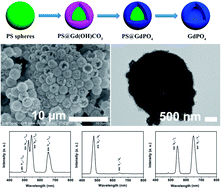Large-scale synthesis and luminescence of GdPO4 hollow microspheres
Abstract
GdPO4 hollow microspheres were synthesized by using a novel multi-step transformation synthetic route for the first time with polystyrene (PS) spheres as the template, followed by the combination of a facile homogeneous precipitation method, an ion-exchange process, and a calcination process. The XRD results indicated that the GdPO4 hollow microspheres have a pure hexagonal phase. The SEM and TEM images confirmed that the as-obtained GdPO4 hollow spheres have a uniform morphology with an average diameter of 2.7 μm and shell thickness of about 150 nm. The up-conversion luminescence properties as well as the emission mechanisms of the GdPO4:Yb3+, Ln3+ (Ln3+ = Tm3+, Er3+ and Ho3+) hollow microspheres were systematically investigated, which show blue (Tm3+, 1G4 → 3H6), green (Er3+, 4S3/2, 2H11/2 → 4I15/2), and red (Ho3+, 5F5 → 5I8) luminescence under 980 nm NIR excitation, providing potential applications in bioanalysis, optoelectronic and nanoscale devices, future color displays and light-emitting devices, and so on.



 Please wait while we load your content...
Please wait while we load your content...